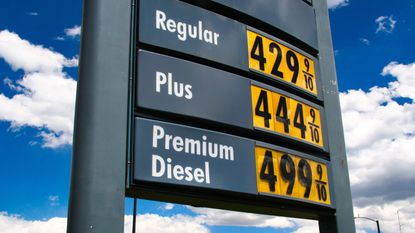Why Are Gas Prices So High If the U.S. Is Energy Independent?
Unfortunately, energy independence can’t keep U.S. gas prices down, and it isn’t enough to protect your stock portfolio either. Here’s why, and what worried investors should know.
- (opens in new tab)
- (opens in new tab)
- (opens in new tab)
- Newsletter sign up Newsletter


We’ve all seen the rising cost of oil and its ripple effect through the economy, especially on prices at the pump. You may have also read that the U.S. is energy independent (opens in new tab) or that we export more oil than we import (opens in new tab) and that Russian oil only makes up 3% of all U.S. oil imports (opens in new tab).
So why are oil and gas prices so high in the U.S.? The national average price (opens in new tab) for a gallon of regular gasoline was $4.24 as of March 30, up from $2.87 a year ago, according to AAA.
Prices Are Global, Not Local
A fundamental economic concept called the law of one price (opens in new tab) can help us understand what is going on. In short, this concept explains that even though the U.S. produces more oil than we use domestically, we buy and sell it on the global market. This means that buying pressures and supply shortages in other parts of the world impact the cost here, even if we produce oil here and use it here. In fact, there is money to be made if you can buy oil in the U.S. at a different price. You could buy in the U.S. then sell internationally and profit from the price difference.

Sign up for Kiplinger’s Free E-Newsletters
Profit and prosper with the best of expert advice on investing, taxes, retirement, personal finance and more - straight to your e-mail.
Profit and prosper with the best of expert advice - straight to your e-mail.
It’s precisely this market force that causes oil — or any other commodity — to trade at one price worldwide. So, even being energy independent, we are still affected by the behavior of the (other) largest oil-producing nations (including Russia, Saudi Arabia, etc.).

Source: U.S. Energy Information Administration (opens in new tab)
What Does This Mean for Your Portfolio?
Besides the pain at the pump, higher oil prices can erode buying power as input and transportation costs for goods and services rise. Protecting one’s portfolio from inflation can be an imperfect science. Gold, commodities, Treasury inflation-protected securities (TIPS) or even bitcoin all offer some level of peace of mind, but each has its quirks.
While not a direct hedge, investors may also want to consider allocating more dollars to companies involved in renewable energy. Over time, as fuel costs rise, one can expect a greater focus and demand for sustainable energy alternatives.
The implications for sustainable energy go beyond climate impact. Russia’s invasion of Ukraine has cast oil dependence in sharp relief, as oil revenue powers the Kremlin. Less demand for oil can mean less dependence on and funding to Russia, as well as other countries whose practices and policies may not align with investor values.
Natural resources may be randomly distributed around the world, but your investments don't have to be.
This article was written by and presents the views of our contributing adviser, not the Kiplinger editorial staff. You can check adviser records with the SEC or with FINRA.

Adam Grealish serves as Head of Investments at Altruist (opens in new tab), a fintech company on a mission to make great independent financial advice more affordable and accessible. With a career rooted in financial innovation, Adam most recently led Betterment's strategic asset allocation, fund selection, automated portfolio management, and tax strategies. In addition, he served as a vice president at Goldman Sachs, overseeing the structured corporate credit and macro credit trading strategies.
-
-
 Courts to Rule on Agency Powers: Kiplinger Economic Forecasts
Courts to Rule on Agency Powers: Kiplinger Economic ForecastsEconomic Forecasts The scope of agency power is under the spotlight in cases in the Supreme and Federal Courts: Kiplinger Economic Forecasts
By Letter Editors • Published
-
 Deeper Regional Banking Crisis Unlikely after Triple Failure: Kiplinger Economic Forecasts
Deeper Regional Banking Crisis Unlikely after Triple Failure: Kiplinger Economic ForecastsEconomic Forecasts Deeper Regional Banking Crisis Unlikely after Triple Failure: Kiplinger Economic Forecasts
By Rodrigo Sermeño • Published
-
 To Afford Retirement, Take Inspiration from ‘The Golden Girls’
To Afford Retirement, Take Inspiration from ‘The Golden Girls’Roommates, a part-time job and renting out your vacation home could be ways to save early in retirement to cover more expensive years later on.
By Erin Wood, CFP®, CRPC®, FBSⓇ • Published
-
 Career Transition? Three Steps to Protect Your Financial Health
Career Transition? Three Steps to Protect Your Financial HealthWhether you’ve been laid off or are moving on voluntarily, career transitions can be stressful, but there are ways to help tame the uncertainty.
By Krystal Barker Buissereth, CFA® • Published
-
 Three Legal Documents Your Child Should Sign When They Turn 18
Three Legal Documents Your Child Should Sign When They Turn 18Legal documents such as durable power of attorney, a healthcare proxy and a HIPAA release can give parents the legal right to make decisions if their child needs help.
By Allen J. Falke, CPA, Esq., LL.M. • Published
-
 Preparing for the Next Recession: Six Considerations for Retirees
Preparing for the Next Recession: Six Considerations for RetireesBeing more disciplined and risk averse in the good times can make it easier to weather the bad times when they inevitably arrive.
By Craig Kirsner, Investment Adviser Representative • Published
-
 Finances Aside, What Does a Happy Retirement Look Like?
Finances Aside, What Does a Happy Retirement Look Like?Three examples of retirees show what it means to thrive in retirement. The common denominators provide clues on how to swing your own happy retirement.
By Dennis D. Coughlin, CFP, AIF • Published
-
 Will You Pay Higher Taxes in Retirement?
Will You Pay Higher Taxes in Retirement?Your Social Security income and RMDs will most likely combine to deliver a tax torpedo, but there are ways to reduce your income in retirement to pay less tax.
By Joe F. Schmitz Jr., CFP®, ChFC® • Published
-
 Inherited Retirement Plan? How to Easily Understand Payout Rules
Inherited Retirement Plan? How to Easily Understand Payout RulesFiguring out first which kind of beneficiary you are will make it easier to grasp the rules and timing on required distributions.
By Mike Piershale, ChFC • Published
-
 For Financial Planning Success Now, Start by Looking at the Past
For Financial Planning Success Now, Start by Looking at the PastCertain beliefs could be impeding your financial planning, and learning what those are begins with exploring your money-related memories.
By Jamie P. Hopkins, Esq., CFP, RICP • Published









